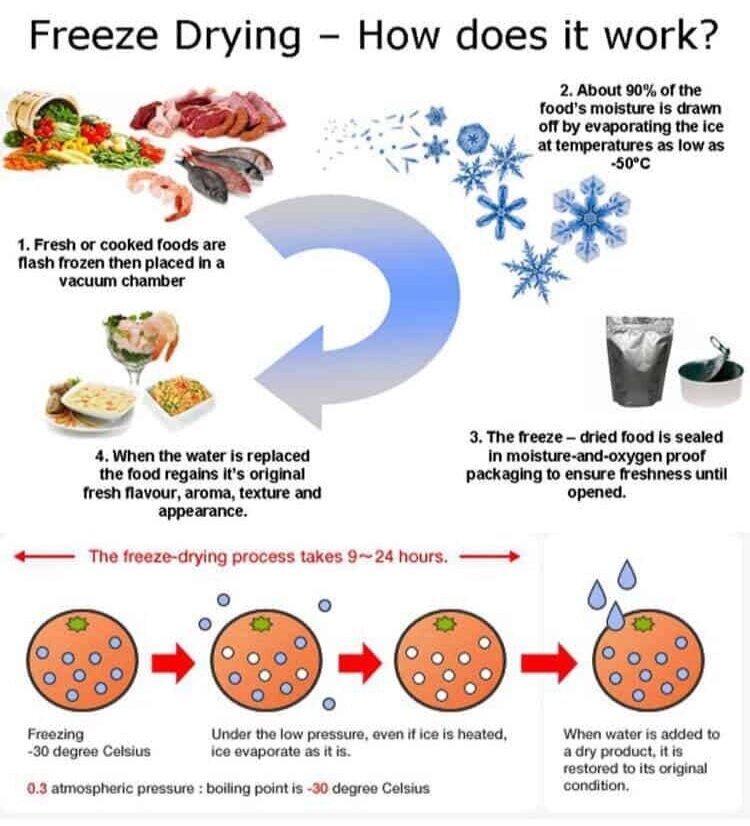When it comes to storing food long term, the age-old question keeps coming up: freeze-dried or dehydrated?
Both can work as part of your emergency food storage, but there are key differences between the two that could make one better than the other for your particular circumstances. Check out these differences and then choose the option that’s best for you.
Shelf Life
Moisture content plays a huge impact on shelf life. The more moisture, the less amount of time it will last. With that in mind, it’s time to compare the moisture content of dehydrated and freeze-dried food.
Dehydrated food can lose quite a bit of moisture–up to 95 percent! However, do-it-yourself home dehydrators may only remove 70% or a food’s water, leaving it with a shelf life of only one year on average. However, most top end dehydrated food will still maintain a shelf life of even longer, up to 15 years or more.
Freeze-dried food, on the other hand, is much more suitable for long-term storage. Getting rid of 98-99 percent of moisture gives freeze-dried food a much lengthier shelf life. Our freeze-dried food has a shelf life of 25 years or more.
While both dehydrated and freeze-dried foods can have long shelf lives, freeze-dried food is definitely superior when it comes to long-term storage. In both cases, however, cooler temperatures will help lengthen their shelf life. We recommend storing your food in temperatures below 70 degrees Fahrenheit.
Preparation
Freeze-dried meals prepare easily. Since everything is pre-cooked, all you need to do is add water, wait a few minutes, and your food is ready for eating! Best of all, it tastes just like it did the day it was created (which might very well have been 25 years ago).
Dehydrated food is a touch different in the way it’s prepared. Instead of letting your food soak for a few minutes, it needs to be cook—boiled, even—in order to rehydrate enough to become the food it used to be. This can take upwards to 20 minutes, depending on the food. While it’s not a huge issue, it can make a big difference if you’re in a hurry.
Nutrition
According to a food science professor at UC-Davis, freeze-dried food maintains most of its nutrients throughout the process, and once rehydrated, is very similar in nutritional value to its fresh counterpart. This is in contrast to dehydrated food which, although much of the nutrients remain, only around 50% – 60% of the original nutrients are left over. In freeze-dried food, there is about 97% of retained nutrients. In this area, freeze-dried food comes out on top.
Taste
Flavor is important in your food. If it doesn’t taste good, why would you even want to eat it? Fortunately, both freeze-dried and dehydrated foods taste great, but there is a difference in the way it’s prepared that makes one taste better than the other.
The taste of freeze-dried food is essentially held in the food, as the process involves very little heat. This keeps in the flavor, retains original texture, and secures the natural scents. This is why many believe freeze-dried food tastes better than dehydrated food, which uses heat to lose moisture, thus forfeiting flavor, original texture, and smell.
Weight
If your food intends to stay in your pantry or with your emergency food storage until used, then weight won’t really be an issue. However, dehydrated and freeze-dried food are delicious treats and meals to take on camping trips, hikes, and even in your bug-out bag, which in turn makes weight play a crucial role.
Dehydrated food is heavier than freeze-dried food, so if you are planning on taking one of these types of foods with you on a hike, freeze-dried food is your best option in terms of being lightweight. If you’re planning on getting a meal out of your food, you’ll want to make sure you either bring enough water or have access to it so you can rehydrate your meals. Many freeze-dried foods, such as fruits, vegetables, and even meats, can be snacked on without rehydrating them, making them a nice, lightweight option for snacking.
There are pros and cons to both dehydrated and freeze-dried food, so in the end it all boils down to what you’re looking for in a food, and how you intend to use it. When it comes to long-term storage and nutrients, however, freeze-dried food reigns supreme. So when you’re looking to invest in an emergency food storage, freeze-dried may very well be the way to go.




